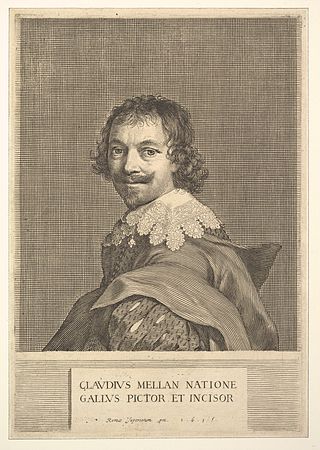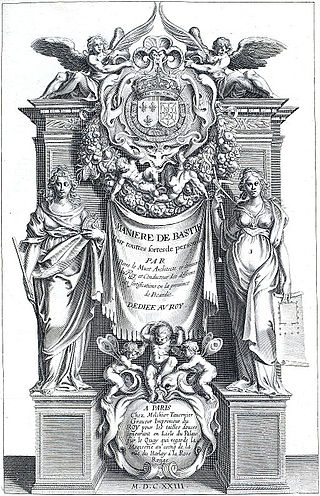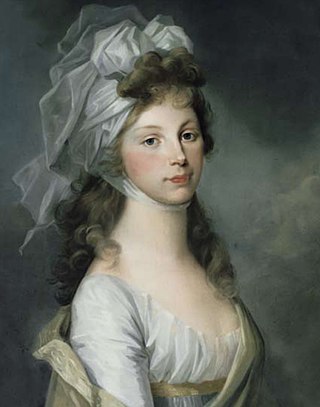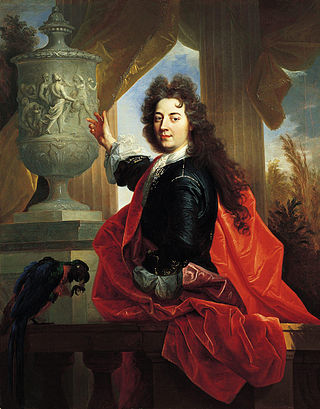
Abraham Bosse was a French artist, mainly as a printmaker in etching, but also in watercolour.

Claude Mellan was a French draughtsman, engraver, and painter.

Pierre Le Gros the Elder was a French sculptor in the service of King Louis XIV.

Pierre Le Muet was a French architect, military engineer, and writer, famous for his book Manière de bâtir pour toutes sortes de personnes, and for the châteaux he constructed, most notably Tanlay in Burgundy, as well as some modest houses in Paris, the grandest of which, the Hôtel d'Avaux (1644–1650) survives and has recently been restored to a semblance of its seventeenth-century condition.

Antoine Lepautre or Le Pautre (1621–1679) was a French architect and engraver. Born in Paris, he was the brother of the prolific and inventive designer-engraver Jean Lepautre. Antoine Lepautre has been called "one of the most inventive architects of the early years of Louis XIV's reign". He was a protégé of Cardinal Mazarin, to whom he dedicated his Desseins de plusieurs palais, in which his imagination is given free rein.

Pierre Lepautre or Le Pautre was a French draughtsman, engraver and architect, especially known as an ornemaniste, a prolific designer of ornament that presages the coming Rococo style. He was the son of the designer and engraver Jean Lepautre and nephew of the architect Antoine Lepautre. His appointment in 1699 as Dessinateur in the Bâtiments du Roi, the official design department of the French monarchy, headed by Jules Hardouin-Mansart and later Robert de Cotte in the declining years of Louis XIV, was signalled by the historian of the Rococo, Fiske Kimball, as a starting point in the genesis of the new style.

The Tassaert family, originating in Antwerp, produced a number of painters, sculptors, illustrators and art dealers, some of whom later settled or worked in France and Prussia in the 17th and 18th centuries. Its members include:

Pierre Lepautre was a French sculptor, a member of a prolific family of artists in many media, who were active in the 17th and 18th centuries. He was born and died in Paris.

Jean Boulanger, a French line-engraver, son of the painter Olivier Boulanger and cousin to the painter of the same name, was born at Amiens in 1608 and baptized in Troyes in Champagne on 24 January 1608; he had five children with Marie Judon. He was documented in Paris in 1645 and resided in the parish of Saint-Etienne-du-Mont.
Jean-François Cars, was a French engraver, printer, publisher and printseller from Lyon.

François L’Anglois or Langlois, also called F. L. D. Ciartres, was a French print publisher, print seller, engraver, bookseller, art dealer, and painter. He is widely considered to have been the first important print publisher in France and to have contributed significantly to spreading awareness of contemporary artists' work throughout Europe.

Nicolas-Henri Tardieu, called the "Tardieu the elder", was a prominent French engraver, known for his sensitive reproductions of Antoine Watteau's paintings. He was appointed graveur du roi to King Louis XV of France. His second wife, Marie-Anne Horthemels, came from a family that included engravers and painters. She is known as an engraver in her own right. Nicolas-Henri and Marie-Anne Tardieu had many descendants who were noted artists, most of them engravers.

Pierre-Simon-Benjamin Duvivier was a French engraver of coins and medals.

Nicolas-Pierre Tiolier was a French sculptor and engraver of coins and medals.

Jacques Lepautre or Le Pautre was a Parisian engraver active during the last quarter of the seventeenth century. Jacques was the son of the prolific printmaker Jean Lepautre (1618–1682) and nephew of architect Antoine Lepautre (1621–1679).

Jean Marot was a French architect and engraver of architectural views. Little has survived of his own architectural work, but his engravings of the works of others, primarily those published in the volumes referred to as the Petit Marot and the Grand Marot (1686), were highly esteemed by his contemporaries and remain, despite numerous inaccuracies and distortions, among the most important sources concerning architecture in France up to the early part of the reign of Louis XIV.

Gilles Demarteau or Gilles Demarteau the Elder was an etcher, engraver and publisher who was active in Paris for his entire career. He is one of the persons to whom has been attributed the invention of the crayon manner of engraving. He is recognized as playing an important role in the development of this engraving technique. He was one of the key reproductive engravers and publishers of the work of François Boucher.

Claude Simpol, Claude Saint-Pol or Claude Saint-Paul was a French painter.

Melchior Tavernier was a French engraver, printmaker and print publisher.

The Hôtel de Ratabon was a Parisian hôtel particulier, constructed in 1664 to the designs of the architect Pierre Le Muet for the French government official Antoine de Ratabon. It was located on a site, which at the time was between the western border of the garden of the Palais-Royal and the rue de Richelieu and is now at 10 rue de Richelieu in the 1st arrondissement of Paris. Antoine de Ratabon died in his house in 1670. It was destroyed in 1873.




















